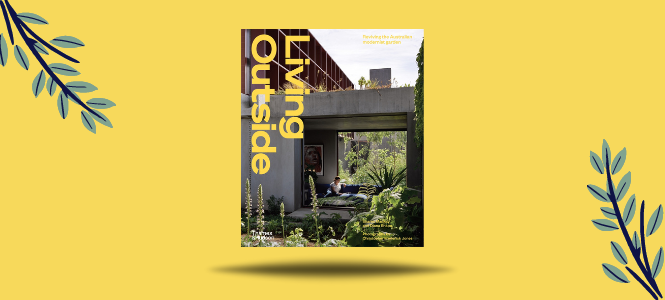Living Outside: Reviving the Australian Modernist Garden is a new book that chronicles the revival of the mid-century modern aesthetic in contemporary Australian gardening, taking its readers on a project-by-project exploration of some of the country’s most stunning outdoor spaces.
Today, we have an extract from Living Outside to share with you – read on to discover the Abbotsford Vertical Garden in Melbourne…
Abbotsford Vertical Garden
Location: Abbotsford, Melbourne, VIC
Traditional lands of the Wurundjeri
Landscape design: Simon Ellis Landscape Architects
Architecture: Rexroth Mannasmann Collective
Dimensions: Site: 90 m2; House: 80 m2; Garden: 4 m2
Climate zone: Mild temperate
Stroll down a typical street in the gentrifying inner suburb of Abbotsford and you’ll find original Victorian terrace houses interspersed with adaptively reused warehouses, new commercial offices and high-density apartments.
What isn’t so typical in Abbotsford, or the surrounding suburbs, is finding a dwelling wrapped almost entirely in a garden. And even more surprising is discovering that this vigorous garden is growing in less than 4 m2 of soil. Home to Francis and his dogs, the entire footprint of this three-storey dwelling is under 100 m2. Its tiny garden provides benefits well beyond many conventional gardens. It screens the home, cools the interior and contributes to the feeling of the entire neighbourhood. From the street, the brick building appears to support a series of vertical gardens punctuated with a striking display of bright red kangaroo paws (Anigozanthos ‘Ruby Velvet’). Closer inspection reveals that this is a simple design solution to the problem of having very little space for a garden in an urban environment. It’s also a demonstration of how gardens can improve our lives, support our wellbeing and create connections well beyond the building envelope. This green jewel was the vision of the developer and owner, who was keen to evoke the lush gardens of Singapore. His ambitious brief included the vertical garden. Delivering that vision on a north-facing site where the building is fully exposed to the sun and heat load of the inner suburbs is, of course, a little tricky.
Early collaboration between the client, architects Rexroth Mannasmann Collective and landscape architect Simon Ellis led to a unique solution to these challenging conditions. The integrated garden offers not just visual relief and pleasure, but maximises the space and improves the performance of the building itself. These benefits are far greater than those in a typical urban housing development, where the garden can sometimes be an afterthought. Inside, the living areas are located over three floors. The northern facade on the second and third floor features windows that fold completely open, removing the barrier between inside and out, extending the small floor area and giving a sense of openness to the sky. The semi-evergreen chocolate vine (Akebia quinata) acts as a draping curtain that screens the hot sun in summer, while still allowing views to the borrowed landscape and street tree canopy beyond. The experience of living in the space is relaxing and peaceful. The need for air conditioning and additional privacy screens is almost entirely removed by the garden and the full-length curtain created by the climber. ‘You look out through the garden, across the rooftops, and all you can see is green canopy,’ says Francis. With the windows open, you can take advantage of the cooling effect of cross ventilation and feel connected to the street below. The bird-attracting, flowering kangaroo paws belie their urban location – you could easily think you were far away from the city.
The planters on the facade have been designed as simple beds incorporated into the design of the building. Integrated irrigation and drainage, lightweight soils and technology borrowed from roof gardens forms the basis for a healthy and rambling garden that supports an evolving plant mix that has been adapted over time. While the hardy kangaroo paw is resilient and showy to the north, the eastern facades supports a pandorea ‘Lady Di’ vine (Pandorea jasminoides white form) that reaches all the way to the roofline and is creeping its way around and, in some places, inside the building. Early failures led to substitution of hardier species, and thriving species were multiplied. Even in the harshest of conditions, the garden is surviving with very little maintenance. Living in higher-density urban homes doesn’t mean compromising on a garden. In fact, it’s easy to imagine that this method of incorporating even the smallest of gardens could be a new pathway to living sustainably in Australian cities.
–Extracted from Living Outside: Reviving the Modernist Garden by Sharon Mackay and Diana Snape, with photography by Christopher Frederick Jones (Thames & Hudson Australia), out on the 27th of October.

Living Outside
Reviving the Australian Modernist Garden
The Australian garden was born mid-20th-century, a time of postwar confidence and growing national identity. Gardens became outdoor rooms for recreation and healthy living - removing the barriers between inside and out - and bold designs celebrated native Australian plants...







Comments
January 13, 2021 at 9:00 pm
I have read so many articles concerning the blogger lovers except this post is
genuinely a nice article, keep it up.
January 29, 2021 at 10:10 pm
Some really superb posts on this web site, thanks for contribution